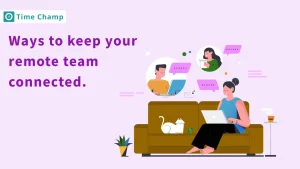Remote work has changed the workplace significantly by offering flexibility, better work-life balance, and access to talent from around the world. But it has its own set of challenges. Managing your remote employees is different than managing in a traditional office. In this blog, we will explore the top 10 challenges of managing remote employees and provide solutions to help you address remote work challenges effectively. Let’s dive in!
1. Communication Gaps
Communication is one of the biggest hurdles in remote work. In a remote setup, employees can’t just walk up to colleagues to clarify doubts like they do in a traditional office. When you don’t have face-to-face interactions, things can get lost in translation, and you can miscommunicate, which leads to delays, frustration, and inefficiencies. Buffer reports show that 52% of remote workers say communication is the biggest challenge.
Solution
To improve communication in remote teams, set clear guidelines for different types of messages. If you need to get in touch for quick questions, give them instant messaging apps such as Slack or Microsoft Teams. Only use email for formal updates or any detailed information. Use video calls for meetings or calls where you want someone to have a personal touch. To make these meetings more productive, consider using AI meeting transcription tools to automatically capture key discussion points and action items, ensuring nothing important gets lost in translation.
Encourage your employees to communicate openly and frequently. Keep regular check-ins to keep on track. Report project status to stay on the same page. Avoid misunderstandings by using virtual team meetings.
2. Loneliness and Isolation
Employees who work remotely can sometimes feel alone, whether they work from home alone or they live in a different time zone. The distance of being away from in-person interaction can cause employees to feel lonely. Therefore, the outcome of this can be negative including employee morale and productivity.
Solution
Virtual team-building activities help avoid isolation and make your employees feel like a community. Schedule virtual coffee chats or casual conversation time where your employees can discuss things that aren’t work-related. Reach out to your team and set up mentorship programs to tie teams from various departments in support and collaboration.
Regularly celebrating wins,
birthdays, and team achievements in
virtual gatherings can also build
team spirit and reduce the sense of
isolation. Following these simple
steps helps your team feel more
connected and
engaged.
Also
read: Fun
Activities for Employee
Engagement in Remote
Workplaces
3. Monitoring Productivity
Productivity monitoring is one of the biggest challenges of managing remote employees. In a traditional office, you can easily see how your team is working. When everyone is working remotely, it can be challenging to monitor their progress. However, this lack of visibility is the cause of concerns about performance and accountability.
Solution
You can set clear performance metrics. Define specific goals for each employee. Then, everyone knows what is expected of them. Checking these metrics regularly will help you to see how your team is doing. It will also help you see where they may need help. You can also keep track of productivity by using, productivity tracking software , such as Time Champ, and project management tools like Time Champ, Trello, or Asana.
These tools help your remote employees see their tasks, deadlines, and progress. But don’t forget that you still need to hold check-ins regularly with your team to check their performance and give feedback to them.
4. Maintaining Employee Engagement
Keeping your employees engaged while they work remotely can be challenging. In an office, it’s easier to create a lively atmosphere. You can chat during breaks and celebrate successes together. But when your team is spread out, they might feel isolated which leads to lower motivation and morale.
Solution
To get better engagement, build opportunities for feedback and recognition. Regular check-ins allow you to encourage staff to share thoughts with you. Ask them for their feedback on work through surveys or one-to-one meetings. It’s great when you listen to their input because they will feel valued and included.
Recognition is also important. Highlight individual achievement or project progress through team meetings. You can create a recognition platform that allows team members to recognize each other’s efforts. It also creates community and motivation for all.
You can keep your remote employees engaged and connected by creating a feedback and recognition culture. It will help increase their motivation and job satisfaction.
5. Time Zone Differences
If you manage a remote team, you will likely work in different time zones particularly if, for example, you hire employees in Spain but are primarily based in the US. This can be a real challenge! Scheduling meetings is tricky when your employees are spread across different locations and time zones. Some team members may be just starting their day and others ready to call it a night. This results in delays in communication and connections.
Solution
Start by using a shared calendar. Using tools like Google Calendar or Outlook can help everyone see each other’s availability. This way, you can find common times to schedule meetings. It keeps everyone informed, no matter where they are in the world. Also, record important meetings as well.
If someone can’t join live, they can watch the recording later. It’s a simple way to keep every employee in the loop. Let your team know when you are online and ready to talk. This way, everyone knows when they can reach out to each other. This approach helps your team feel valued and connected, which is essential for a happy and productive workplace.
6. Lack of Visibility into Employee Work
One major challenge you face when managing remote teams is the lack of visibility into what your employees are doing. When your team is working from home, it can be hard to see who is busy and who needs support. You might feel a bit out of the loop, and that’s not a great feeling for you and your team.
Solution
You can make an environment where every employee can talk openly. Conduct quick daily stand-up meetings. These meetings are a chance for everyone to share what they are working on and their challenges. You can also use Time Champ’s live screen for real-time monitoring features to help you see exactly what your employees are working on without interrupting or disturbing them.
This helps keep you informed and also helps your team feel connected. You can also easily find a solution when they share their update. And don’t forget to build trust with your team. If your employees don’t trust you, they will not be open with you about their progress or any problems they encounter.
7. Technology & Security Issues
Remote employees are challenging to manage because they are related to technology and security. Slow internet, outdated software, and system crashes are some of the tech issues that interrupt the work. Employees usually have a problem troubleshooting their problems without IT support.
Security is another big issue. When your employees work remotely, data breaches, phishing attacks, and unauthorized access to company-sensitive information increase. Connecting from home networks and personal devices makes the business vulnerable.
Solution
Provide your employees with reliable tools and safe devices. Ensure they have easy IT support. You need to create a clear cybersecurity policy. Guidelines for VPN usage, strong passwords, and safe file sharing should be included to minimize risks.
Prepare your remote team with regular security training. Inform employees how to be able to identify red flags. It helps them to avoid problems before they get big. Some of the tech and security challenges can be managed but only if you have the right strategies.
8. Work-Life Balance Struggles
Working remotely sounds great, but it’s tough to keep a healthy work-life balance. The home becomes the office, so personal and professional time tend to overlap. If employees think they always have to be available, this can cause burnout.
Employees can get distracted at work hours doing household chores and family responsibilities. And some even struggle with switching off after work. Sometimes they would keep checking their emails, or they would be done with their work later in the night. This creates an imbalance that over time drains energy and reduces productivity.
Solution
If you want to support your team, encourage healthy boundaries. Tell them to establish work hours setting and make sure to stick to them. Let your employees take breaks. Tell your employees to set up a specific workspace at their home. Open communication is key. Ensure you check in frequently to find out how your team is dealing with their workload.
Advise on how to manage time, and to prioritize certain tasks. If your employees know they feel supported more, they can be healthier in their work-life balance. When you solve these problems, you create a more productive and happier remote workforce.
9. Onboarding New Remote Employees
Onboarding new remote employees is a tricky process. Remote onboarding is different than traditional settings where new hires can meet face-to-face and get settled quickly. Without the right support, it’s easy for new team members to become overwhelmed feeling isolated.
Onboarding is the first impression of a new hire. Through the Process, they get to understand company culture, policies, and their roles. If they don’t have it, they may not feel connected or engaged.
Solution
Give a clear schedule for the first week or two. Include meeting new team members, training sessions, and of course meetings. That helps new hires visualize what they are getting into and feel a little more comfortable. Create virtual meet and greets to help new employees meet their teammates. Ask team members to share their experiences and insights. It creates a sense of belonging.
Don’t forget about training. Give easy access to resources such as tutorials and guides. Make sure new employees know what tools they will be using. Think about having a buddy or mentor to walk them through their first days. When you put time into a thoughtful onboarding process, you’re setting up new remote employees to succeed in their roles.
10. Cultural Differences
When managing a remote team, you will be working with people from different cultural backgrounds. Their culture brings values, communication styles, and perspectives. This diversity can boost creativity but it can also lead to misunderstandings.
The difference in cultures can confuse team interactions. Feedback is likely to be misunderstood by the employees. This is a crucial step for building a cohesive team when you recognize these cultural differences.
Solution
To overcome cultural differences, it is necessary to make an effort and increase the concerns about cultural differences within the group. Encourage team members to share holidays or traditions of their culture. It can build empathy, and create connections among employees.
Better collaboration happens when employees understand and respect backgrounds. You create a more inclusive, productive remote work environment by discussing cultural differences.
Conclusion
Managing remote employees presents unique challenges, from communication issues to maintaining productivity. Knowing these barriers is the first step towards a solution like having check-ins and creating a good remote team culture. By implementing these strategies, you can create a more connected and motivated workforce. Remember, overcoming these challenges not only improves efficiency but also enhances employee satisfaction .
Manage your remote employees effortlessly with Time Champ.
Signup for Time Champ now and track performance in real-time!
Signup for FreeBook DemoFrequently Asked Questions
Several difficulties arise with managing remote employees. The potential challenges are the lack of communication, loneliness, problems with controlling the employees’ performance, handling the difference in working time zones, and managing technology issues. Every challenge needs specific solutions to address the issue of team cohesiveness and performance.
The first step towards establishing trust in a remote team is through communication. Share your expectations and make sure that your team also shares them. Thank them for their contribution and ask them to express their ideas and concerns. When people are given attention and listened to, they will begin to trust the organization.
It is important to ensure that remote employees have a good work-life balance. It is also essential to specify and get the employees to follow the working hours. Resources that can be given to employees on time management and flexibility can also help employees manage their work in their personal lives.
Tools such as Time Champ, Tello, or Asana will help you track tasks. Tools like Slack or Microsoft Teams can help with this as they enable a team to quickly send messages to each other or communicate with each other. Modern tools such as Zoom or Google Meet are important for virtual meetings as they allow for building relations even if people are not in the same place.
Addressing performance issues with remote employees requires a thoughtful approach. Begin by having a private conversation to discuss your concerns. Use specific examples to illustrate your points. Collaboratively set clear goals and expectations moving forward.






